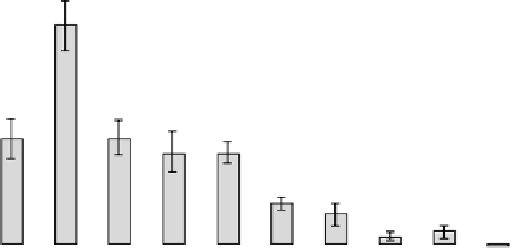Biomedical Engineering Reference
In-Depth Information
4800
3800
2800
1800
800
-200
Figure 13.4
Comparison of percent increase in peak
D
after compound treatment.
Y
-axis is percent
increase in peak
D
. Data presented as meanSE (
N
¼20 or 30).
13.4 CONCLUSIONS
In recent studies, PTZ, which induces seizures in rodents (Ferrendelli
et al., 1989), induced seizure-like zebrafish movement as well as a characteristic
seizure EEG profile in zebrafish brain (Baraban et al., 2005; Winter et al., 2008).
Winter et al. (2008) assessed additional compounds known to cause seizures in
mammals focusing on high-speed movement (greater than 20mm/s). In this
study, to further validate the zebrafish seizure assay, we assessed nine com-
pounds known to cause seizures in mammals and zebrafish including PTZ, 4-AP,
picrotoxin, strychnine hemisulfate, methoxychlor, amoxapine, aminophylline
hydrate, bicuculline methiodide, and enoxacin. The assay correctly predicted
results for eight of the nine seizure inducing compounds and lidocaine, a
negative control compound. Therefore, overall predictivity was 90% and sen-
sitivity was 89%.
In addition to distance traveled at high speed, we examined the kinetic patterns
of high-speed seizure-like movement, including time to peak
D
, duration of peak
D
,
and time to return to base level of high-speed movement, which varied by compound
(Fig. 13.2). Differences may be due to rate of compound absorption or bioavail-
ability, compound solubility or stability, experimental conditions, receptor binding
affinity, or other factors. In subsequent studies, we are investigating if kinetic
patterns can be used as fingerprints to categorize potential seizure inducing
compounds by target or mechanism of action.


Search WWH ::

Custom Search